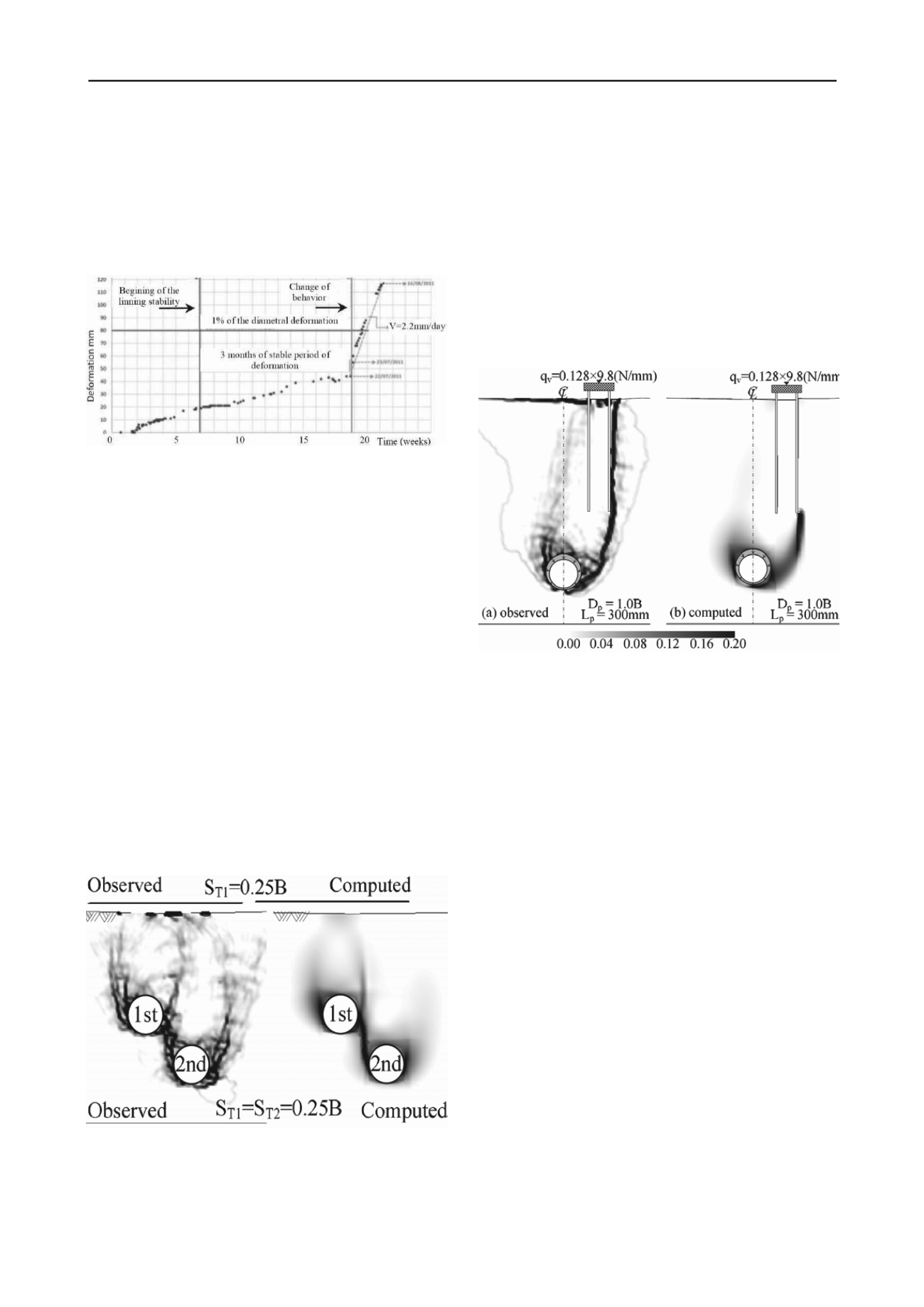
1674
Proceedings of the 18
th
International Conference on Soil Mechanics and Geotechnical Engineering, Paris 2013
out to evaluate if this anomalous behaviour could be attributed
to the reactivation of the cracks. The modelling methodology
achieved great results with lining displacements of the same
order of magnitude to the in-situ observations. Figure 2 presents
the convergence of a lining section below the channel that was
dredged, however the authors of the general report believe that
the division entitled “Beginning of the lining stability” was
intended to state instability.
Figure 2. Ring 671 time evolution of deformation (after Rangel-Núñez
et al.
).
In their paper “Design of tunnel lining in consolidating soft
soils”,
Rodríguez-Rebolledo
et al.
study the effects of
consolidation on the lining by a series of FEA. The Mexico City
valley is affected by an on-going regional subsidence process
associated to intense pumping of water from the aquifer below
the urban area. This process is locally combined with the
consolidation due to the excess of pore pressure generated by
the excavation of the tunnel and installation of the primary liner.
A multistep FEA was performed and several tools to account for
plastic flow of lining, joints and interfaces were applied. The
results indicate a very unfavourable condition for the final
lining, with vertical loading and horizontal confinement loss.
Shahin
et al.
combine 1:100 centrifuge model tests with 2D
FEA to analyse the excavation of twin tunnels with different
relative positions and the excavation of a single tunnel beneath a
strip and a pile foundation. Their study is entitled “Rational
interpretation of tunnelling considering existing tunnel and
building loads”. The results calculated with the modelling tools
applied and the elastoplastic subloading
t
ij
constitutive model
are in remarkable agreement with the centrifuge model tests.
The relative position of the twin tunnels influences the surface
settlement magnitude as well as the region of intense shear
strain that occurs between the two tunnels, as displayed in
Figure 3 for the condition of diagonal alignment.
Figure 3. Observed and computed strain distribution with diagonally
located tunnels (after Shahin
et al.
).
The presence of a building load above the tunnel excavation
shifts the settlement trough from the tunnel line to the load line.
In terms of strains distribution the study revealed the occurrence
of a shear band from the building load, either for strip or pile
foundation, to the closest side of the tunnel, as displayed in
Figure 4.
Li
et al.
in their paper “An evaluation of influence factors
that affect pressures in backfilled trenches” present the case for
a rational approach to the design of conduits buried in trenches.
The assessment of the vertical stress on the conduit based on
analytical solutions may result in a underestimated value. A
numerical analysis with FLAC was performed to reveal the
relative importance of each soil and geometric parameter on the
vertical stress distribution on the conduit. The results indicate
that the geometric layout of the trench and the soil resistance
parameters are the most influencing factors. It would have been
of great value if these data were compared to the existing
analytical solutions.
Figure 4. Observed and computed strain distribution for a tunnel
beneath a piled foundation (after Shahin
et al.
).
Kobayashi and Matsumoto
present an upper bound limit
analysis solution in their paper “On the stability of a trap door
evaluated by upper bound method”. A typical roof failure
situation is analysed with a parabola-shaped loosened soil zone,
falling down vertically. The solution is displayed in design
graphs. With these graphs it is possible to depict at what
conditions the trap door is stable without support as well as the
increase in the arching effect in case of narrow conditions.
Mazek and El Ghamrawy
use data from The Greater Cairo
metro for a thorough comparison of different surface
settlements prediction methods. The results are presented in
their paper “Assessment of empirical method used to study
tunnel system performance”. The study discussed that the
empirical method proposed by Peck and Schmidt (1969) is
unable to properly differentiate distinct sand conditions. An
elastoplastic constitutive model with the elastic modulus as a
function of the confining stress was employed in 2D FEA and
resulted in a good agreement between FEA predictions and field
measurements for different sand conditions, from loose to very
dense sand, which is remarkable since the with FEA calculated
troughs are usually too wide.
Köppl and Thuro
propose a model for rational planning of
hyperbaric interventions to change cutting tools of Mix-Shield
TBMs that would avoid critical geological zones and reduce
unnecessary intervention costs, as discussed in their paper
“Cutting tool wear prognosis and management of wear-related
risks for Mix-Shield TBM in soft ground”. 18 TBM drives were
analysed in terms of soil conditions and TBM characteristics in
order to develop the empirical model for the service life of the
cutter tools.
The results could not achieve a reliable correlation of one
individual soil parameter to the wearing of the cutting tools.
Therefore, the hardness of the soil, the stress at the contact
surface and the shape parameter of the soil components were
combined in a new parameter called Soil Abrasivity Index


